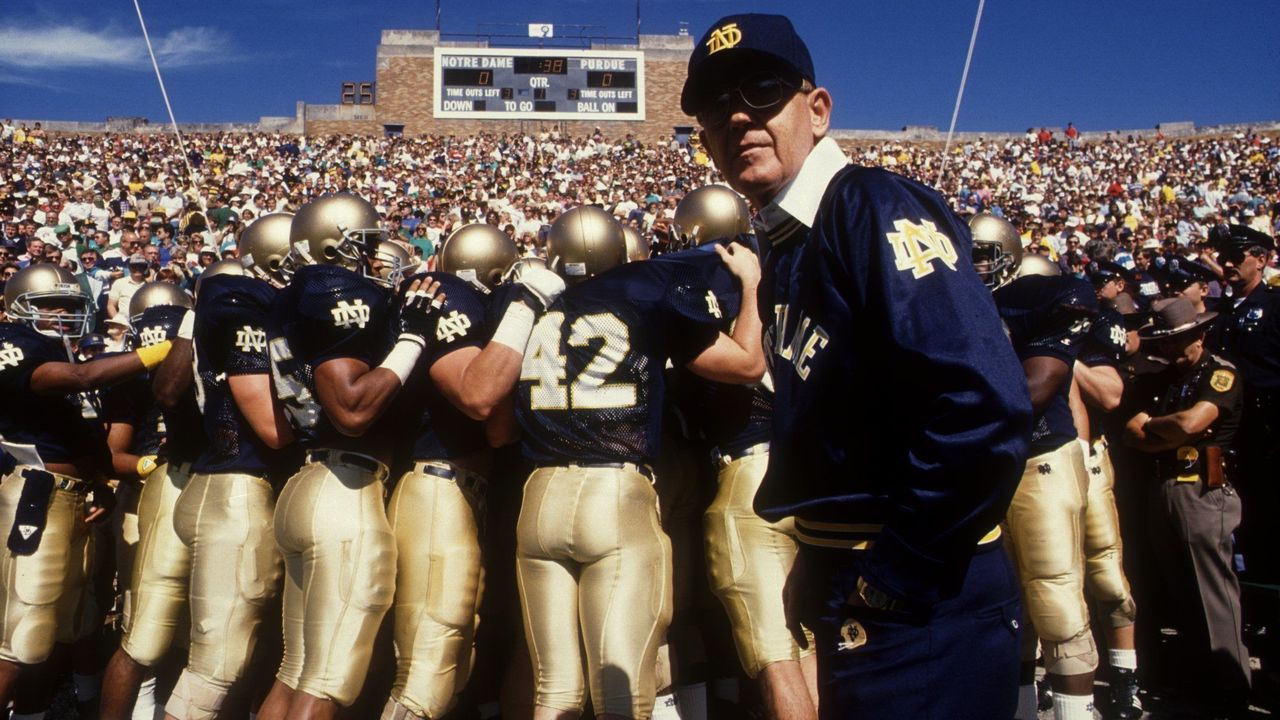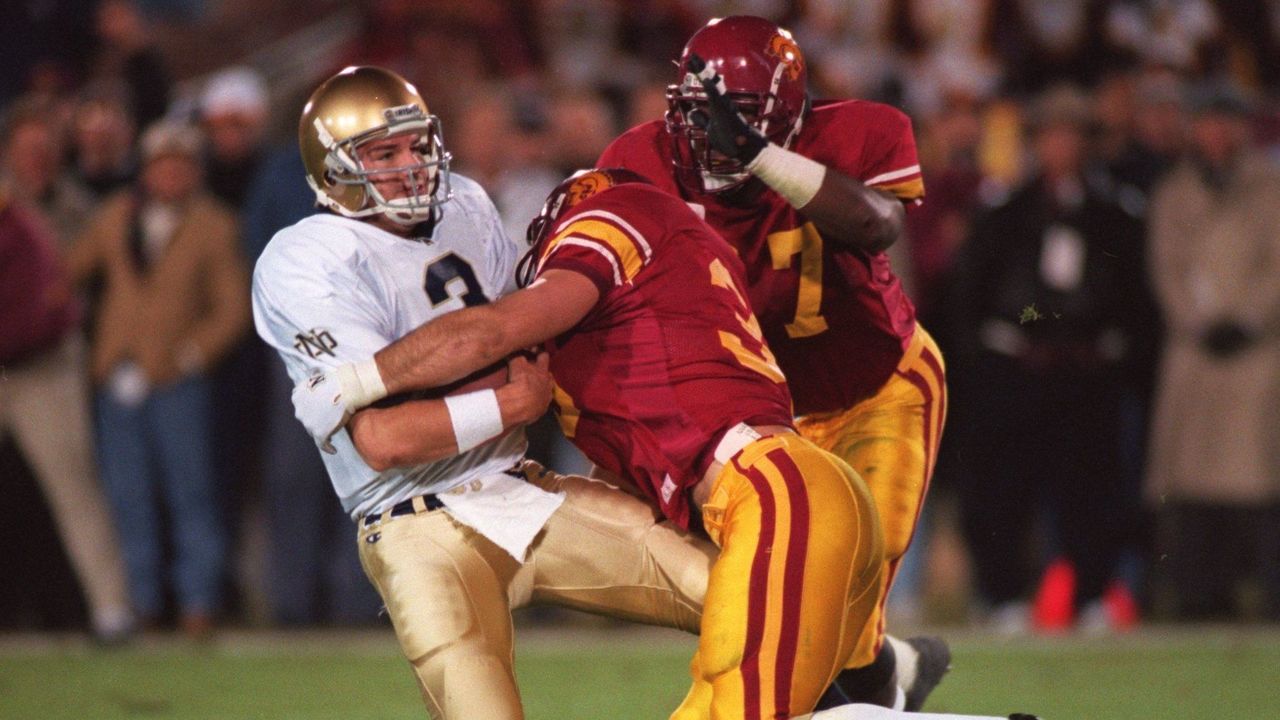Love to hate: Elite history highlights cross-country USC-Notre Dame rivalry
Virtually every major college football rivalry in the country is based around one common element: Location.
Deep-seeded hate between players, schools, and fan bases exists because of how close they are to one another. That proximity leads to interaction on a day-to-day basis; fresh reminders how annoying the opposition can be.
That idea leads to a very important question: Just how the heck did Notre Dame and USC grow one of the best rivalries in the country when the respective campuses are over 1,800 miles apart?
Distance between schools: 1,818 miles
Series record: Notre Dame leads 47-37-5
Trophy: Jeweled Shillelagh
Why they hate each other
Almost every college football rivalry is based on hate, but that isn't necessarily the case with Notre Dame and USC, especially when looking at the history of the matchup.
The most entertaining story as to how this cross-country rivalry began involves a pair of wives. A meeting between the wives of Notre Dame head coach Knute Rockne and USC administrator Gywnn Wilson is thought by many to have hatched the annual game between the two powerhouses.

The Trojans were on the lookout in the mid-1920s for a national rival, so the school dispatched Wilson and his wife to Lincoln, Neb., for the Thanksgiving Day matchup between the Cornhuskers and the Fighting Irish. Rockne was allegedly against the idea of a home-and-home with USC due to the travel, but Wilson's wife convinced Mrs. Rockne that a trip to sunny Los Angeles every two years was something to be desired.
The wives story is certainly the most interesting, but the origin of the rivalry is likely based upon a number of other reasons as well. Despite being located in the heart of Big Ten Country (then the Western Conference), the member schools wouldn't play Notre Dame due a ban the conference set forth. Needing to fill their schedule with national opponents, Notre Dame began looking westward at the lobbying of the school's graduates that lived in California.
Once Notre Dame and USC realized the lucrative potential of the annual game, the series was born.
Another link between the schools came with Trojans head coach Howard Jones. After the 1924 season, USC approached Rockne about becoming its new football coach. The legendary Notre Dame man would turn the offer down but suggest that the school look at his friend, Iowa coach Jones. The Trojans would eventually sign Jones for the job, a move that worked out brilliantly for USC, as Jones would post a 121-36-13 record with the school and four national championships.
The first game played was in 1926, a 13-12 win for Notre Dame in Los Angeles. The next year would see an estimated 120,000 people watch the Irish win 7-6 at Soldier Field in Chicago.
If location is the common thread that bounds the beginning of most rivalries, dominance is the element that linked these two powerhouses in the early stages. From 1928-32, the schools combined to win the national championship five straight times.

That may have been the first glory period of the rivalry but it certainly wouldn't be the last as the two schools combined for eight national championships during a 16-year run from 1962-78. That time period was also highlighted by the fiery battle between coaches John McKay and Ara Parseghian.
While the rivalry will be strong among graduates of both institutions regardless of quality, the significance on the national stage has died in recent years as both teams drop from the national championship picture.
Despite that, it's important to remember that some of the greatest teams and players in college football history have been part of this rivalry, leaving quite the legacy over the 92-year run.
| Notre Dame | USC | |
|---|---|---|
| National Titles | 11 | 10 |
| Heisman winners | 7 | 6 |
| College Hall of Famers | 45 | 34 |
*USC's 2004 BCS Championship was later vacated, as was Reggie Bush's Heisman Trophy
Quotables
"Southern Cal's brand is about as far away from South Bend as you can get. It's glitz and glamour versus lake effect and grey skies." - Tom Rinaldi, ESPN broadcaster
"USC stands for University of Spoiled Children. Most of the football players chose USC over UCLA because it's easier to spell." - Former Notre Dame coach Lou Holtz, 2013 Pep Rally
Moments
For anyone that is under the age of 40, there is one moment in this storied history that stands alone above the rest; the play known as "the Bush Push." USC got the ball with just over two minutes to play and drove the length of the field, setting up on the Irish 1-yard line with seven seconds to play. Quarterback Matt Leinart would try for the sneak, and thanks to a massive push by Reggie Bush, would find the end zone for the winning score.
The early years of this rivalry featured many classic games, but the 1931 contest certainly ranks among the most significant. USC won for the first time at Notre Dame Stadium, erasing a 14-0 win to emerge victorious on Johnny Baker's late field goal. The Trojans, who snapped a 26-game unbeaten streak for the Irish with the win, were reportedly greeted by more than 300,000 fans when they returned home.
The 1988 contest saw the first time ever that the teams entered ranked No. 1 and No. 2 in the country. The Fighting Irish would head west and emerge with the 27-10 win, led by Tony Rice's 65-yard touchdown. Notre Dame would end up winning the national championship that year with a victory over West Virginia in the Fiesta Bowl.
Notre Dame was the defending national champion when they came to Los Angeles in 1974 and jumped out to a shocking 24-6 lead over the home team. That would lead to one of the most improbable comebacks in college football history, as the Trojans would rip off 49 straight points with Anthony Davis going 102 yards on a kickoff return to get things going.